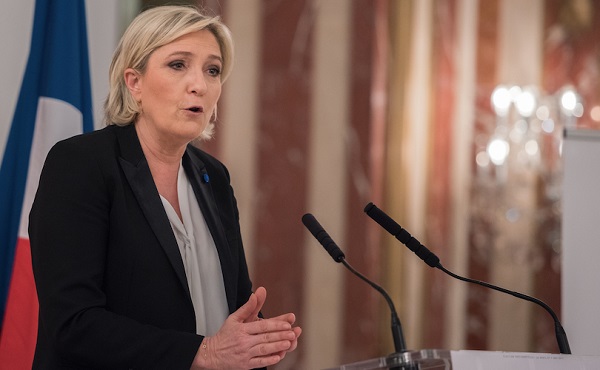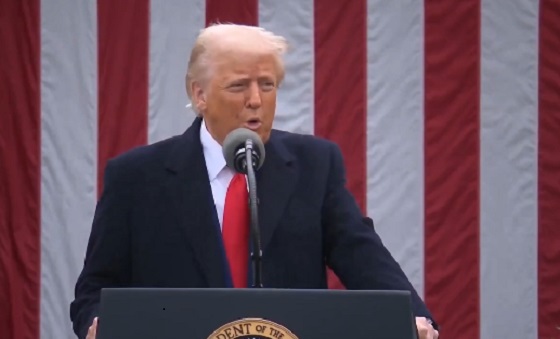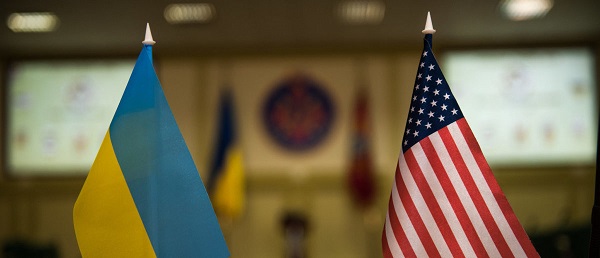Business
Trudeau’s Delusion Meets Trump’s Tariffs: 25% Hit on Canada and Mexico Could Cripple Economies Overnight!

In a fiery Truth Social post on November 25th, Donald Trump made his position crystal clear: the days of open borders, unchecked drug smuggling, and illegal immigration are over. The president-elect, set to take office in January, declared that one of his first actions as commander-in-chief will be to slap a 25% tariff on all goods from Mexico and Canada until both nations “use their absolute right and power” to stop the flow of drugs and illegal immigrants into the United States.
The Trump Doctrine Returns
This announcement serves as a bold reminder of Trump’s “America First” strategy, which dominated his first presidency. According to Trump, the current state of the U.S.-Mexico border is a “national emergency,” with caravans from Mexico allegedly bringing record levels of drugs like fentanyl and waves of illegal migrants. Canada isn’t off the hook either, as Trump accuses Justin Trudeau’s government of maintaining what he calls “ridiculous open borders” that have contributed to the crisis.
“Both Mexico and Canada have the absolute right and power to easily solve this long-simmering problem,” Trump stated. “Until such time that they do, it is time for them to pay a very big price!”
Economic Weapons Locked and Loaded
The proposed tariffs are no small matter. A 25% import tax on goods from Canada and Mexico could cripple their export-driven economies, both of which are heavily reliant on U.S. trade:
- Mexico: Over 80% of its exports head to the U.S. A 25% tariff would devastate industries like auto manufacturing, agriculture, and electronics.
- Canada: With 75% of exports destined for the U.S., Canadian businesses are bracing for significant disruptions to key sectors, including energy and auto parts.
Experts warn that these tariffs would also raise prices for American consumers. But Trump’s post signals he’s unfazed by potential backlash. “It’s time for these countries to pay a very big price,” he declared, echoing his tough-on-trade rhetoric from the 2016 campaign trail.
The Bureau – Canada’s Role in the Fentanyl Epidemic
According to The Bureau, U.S. investigators have uncovered a direct connection between Canadian cities—particularly Toronto and Vancouver—and transnational fentanyl money-laundering networks. These networks, allegedly run by Triads with ties to Beijing, are laundering cash for Mexican cartels smuggling fentanyl precursors from China.
David Asher, a former Trump administration official and DEA consultant, didn’t mince words in his interview with The Bureau. He stated that U.S. intelligence points to Canada as the “command and control” hub for these networks, which have fueled the devastating fentanyl crisis.
“When we seized their phones, we’d see Canada light up like a Christmas tree,” Asher said, highlighting how Toronto and British Columbia play central roles in these operations.
Canada’s Tariff Crisis: The Numbers Don’t Lie
Let’s dig into the cold, hard facts, courtesy of the Canadian Chamber of Commerce, and they’re downright devastating. Trump’s proposed tariffs aren’t just a political statement—they’re an economic wrecking ball aimed squarely at Canada’s most vulnerable industries. For Justin Trudeau’s government and hapless premiers like David Eby, these numbers are a brutal wake-up call.
The Trade Dependency Trap
Canada’s economic lifeblood is deeply tied to the United States, with 41% of Ontario’s GDP and a staggering two-thirds of New Brunswick’s GDP linked to cross-border trade. And it’s not just Canada feeling the squeeze—states like Michigan (14% GDP dependency) and Illinois (10.2%) rely heavily on Canadian trade.
The kicker? Nearly 63% of Canadian exports to the U.S. are intermediate inputs, meaning they’re critical components for American manufacturing. Canada isn’t just exporting products; it’s exporting the gears that keep U.S. industries turning.
Energy and Autos: The Collateral Damage
Consider this: in the first half of 2024 alone, Canada exported $85 billion in energy and $40 billion in auto parts to the U.S. A 25% tariff would obliterate these sectors, dragging down both economies in the process. And while Trudeau and his team posture about “standing united,” it’s clear their lack of preparation will only deepen the pain for Canadians.
Tariff Fallout: A National Recession Looms
The numbers paint a grim picture: a 25% tariff would deliver a 2.6% GDP decline annually for Canada, costing the average Canadian $2,000 CAD per year in lost income. Add in retaliatory tariffs, and this spirals into a full-blown recession, with cascading impacts on productivity, supply chains, and jobs.
- Auto/Transport Exports: Down 10 percentage points.
- Basic Metals Exports: Down 9 percentage points.
- Chemicals and Paper Products: Exports drop by 8% and 7%, respectively.
- Overall Sector Decline: A staggering 22 percentage points for critical industries.
Meanwhile, cross-border investment—once a pillar of Canada-U.S. relations—is under threat. Canadian investments in the U.S. total $1.1 trillion, but a tariff war risks destabilizing these flows and gutting the broader economic relationship.
Last Weeks Spin Piece from the Canadian Press
As we look at the fallout from Trump’s 25% tariff announcement, let’s take a moment to laugh at this spin piece from the Canadian Press that came out just last week. The article tried to paint a picture of Canada’s Foreign Affairs Minister Mélanie Joly claiming that Donald Trump’s return to the White House has somehow boosted Canada’s influence on the world stage. Yes, you heard that right—Canada, the same country with open borders, an overreliance on U.S. trade, and a prime minister whose leadership is about as effective as a broken clock, is supposedly advising the world on how to handle Trump.
Joly boldly declared from the Asia-Pacific Economic Cooperation summit in Lima, “No country understands the United States better than Canada.” According to her, nations are lining up to learn from Canada’s experience with Trump, as though Trudeau and his team have some masterclass on navigating Trump’s policies. Fast forward to today, with Trump poised to slam Canada with tariffs that could destroy their economy, and the absurdity of this claim is glaring.
This narrative that Canada is a calm, steady hand amid Trump’s return is nothing more than a fantasy. While Joly and Trudeau were hobnobbing at summits, Trump was gearing up to deliver real consequences. His 25% tariff on Canadian imports isn’t hypothetical—it’s a financial wrecking ball aimed at an economy that relies on U.S. trade for survival. Energy exports, autos, and agriculture—the pillars of Canada’s economy—will take a direct hit. But instead of preparing for this, Joly was busy spinning a tale of Canada’s supposed “influence.”
And let’s not forget what Joly was selling in that article. “Canada’s influence is actually increasing because of the impacts that the world is now facing with the new administration.” Increasing? On what planet? Trump’s tariffs make it clear that Canada isn’t leading anything; it’s scrambling to react.
The article also floated the idea that Trudeau was in a “privileged position” because of his past dealings with Trump. Let’s recall how that went, shall we? Trudeau was caught mocking Trump on a hot mic during a G7 summit, embarrassing himself and the country in front of world leaders. His government barely held onto a renegotiated NAFTA—now the USMCA—that Trump rewrote to suit America’s interests. If this is the kind of experience Trudeau brings to the table, it’s no wonder Canada is in trouble.
Meanwhile, the Canadian Press tries to prop up Trudeau as some staunch defender of “rules-based trade,” as though those rules mean anything when Trump has the leverage to rewrite them. Joly spoke about sending “clear messages” to Beijing, yet Trump’s tariff threats expose just how little Canada has done to address the very issues Trump is targeting. Let’s not forget The Bureau’s report on Canada’s role in fentanyl money laundering, with Toronto and Vancouver lighting up as command centers for Triads laundering cash from Mexican cartels. Canada’s failures are part of the problem Trump is confronting.
And here’s the kicker: as of today, neither Trudeau nor Joly has made a peep about Trump’s tariff announcement. No tweets, no press statements, no leadership—just silence. So much for being the world’s go-to expert on Trump. Canada’s leaders are AWOL while Trump tightens the economic screws.
While our beloved PM is silent, Jagmeet Singh, ever the opportunist, couldn’t resist wading into the chaos with his usual brand of hollow theatrics. “Stand up and fight like hell,” he bellowed at Justin Trudeau on Twitter, as though anyone has ever mistaken Singh for a warrior of any kind. Let’s be honest—Singh’s idea of “fighting like hell” probably involves drafting another toothless motion in Parliament or throwing shade on social media while offering zero solutions. This is the same guy who props up Trudeau’s government with his NDP-Liberal supply-and-confidence deal, enabling the very weakness he’s now trying to criticize. Spare us the tough talk, Jagmeet. Bootlicking Trudeau one day and grandstanding the next doesn’t exactly scream credibility.
And as for Trudeau and Mélanie Joly? Their performance over the last week has been nothing short of delusional. While Trump was setting the stage to unleash a 25% tariff that could dismantle Canada’s economy, Trudeau was busy posturing at international summits and snapping photos with global elites. Joly, for her part, claimed that Trump’s return to power somehow boosted Canada’s global influence—because apparently being a punching bag now counts as diplomacy.
This isn’t global influence; it’s global irrelevance. The Trudeau government spent the last week basking in delusion while Trump was preparing to drop the hammer. And now the clock has run out. Stay tuned—because while Trudeau dithers and Singh flails, the reckoning is here.
Final Thoughts
Trump campaigned on a clear and powerful message: tariffs are a weapon to protect American workers and restore national sovereignty. And, folks, he wasn’t wrong. Sure, input costs might rise. Sure, a few elites will clutch their pearls as their profits shrink. But this isn’t about them. This is about something bigger. It’s about standing up for the forgotten workers in Michigan, Ohio, and Wisconsin who’ve watched their livelihoods vanish thanks to decades of globalist betrayal. Trump’s message is loud and clear: no more one-sided trade deals, no more globalist bull. America comes first.
And what about Canada? What has Justin Trudeau done? He’s alienated an entire nation while dividing our own country with his disastrous, virtue-signaling policies. Trudeau doesn’t just dislike the West—he actively works against it. The West pays the bills in this country, folks. Alberta’s oil sands, Saskatchewan’s agriculture, and British Columbia’s resources prop up this nation’s economy. And how does Trudeau repay them? By demonizing their industries, their workers, and their very way of life to appease his climate cult.
While Trudeau struts on the world stage preaching green fantasies, the West bears the cost. It’s their jobs, their industries, and their communities that are hollowed out to fund his carbon tax schemes. Now, with Trump’s tariffs about to slam Canada’s economy, the true cost of Trudeau’s failures is finally coming home to roost.
How can Canada face this crisis when our so-called leader is more concerned with photo ops, platitudes, and meaningless “climate leadership” than standing up for our country? Trudeau has alienated our most important trading partner, antagonized the West, and is now leaving us unprepared for a showdown with Trump’s America.
Let’s look at the facts. Canada is at odds with China, embroiled in a cold war with India, and now staring down Trump’s tariffs. Every move Trudeau makes puts us further into isolation, weaker and more vulnerable. So here’s the question: can we really afford another year of this man at the helm?
The Trudeau government has run out of excuses, out of allies, and now, out of time. This isn’t just about whether Canada can survive Trump’s tariffs. It’s about whether we can survive another year of Justin Trudeau’s leadership. The reckoning is here, and Canada deserves better.
Banks
Wall Street Clings To Green Coercion As Trump Unleashes American Energy


From the Daily Caller News Foundation
By Jason Isaac
The Trump administration’s recent move to revoke Biden-era restrictions on energy development in Alaska’s North Slope—especially in the Arctic National Wildlife Refuge (ANWR)—is a long-overdue correction that prioritizes American prosperity and energy security. This regulatory reset rightly acknowledges what Alaska’s Native communities have long known: responsible energy development offers a path to economic empowerment and self-determination.
But while Washington’s red tape may be unraveling, a more insidious blockade remains firmly in place: Wall Street.
Despite the Trump administration’s restoration of rational permitting processes, major banks and insurance companies continue to collude in starving projects of the capital and risk management services they need. The left’s “debanking” strategy—originally a tactic to pressure gun makers and disfavored industries—is now being weaponized against American energy companies operating in ANWR and similar regions.
Dear Readers:
As a nonprofit, we are dependent on the generosity of our readers.
Please consider making a small donation of any amount here. Thank you!
This quiet embargo began years ago, when JPMorgan Chase, America’s largest bank, declared in 2020 that it would no longer fund oil and gas development in the Arctic, including ANWR. Others quickly followed: Goldman Sachs, Wells Fargo, and Citigroup now all reject Arctic energy projects—effectively shutting down access to capital for an entire region.
Insurers have joined the pile-on. Swiss Re, AIG, and AXIS Capital all publicly stated they would no longer insure drilling in ANWR. In 2023, Chubb became the first U.S.-based insurer to formalize its Arctic ban.
These policies are not merely misguided—they are dangerous. They hand America’s energy future over to OPEC, China, and hostile regimes. They reduce competition, drive up prices, and kneecap the very domestic production that once made the U.S. energy independent.
This isn’t just a theoretical concern. I’ve experienced this discrimination firsthand.
In February 2025, The Hartford notified the American Energy Institute—an educational nonprofit I lead—that it would not renew our insurance policy. The reason? Not risk. Not claims. Not underwriting. The Hartford cited our Facebook page.
“The reason for nonrenewal is we have learned from your Facebook page that your operations include Trade association involved in promoting social/political causes related to energy production. This is not an acceptable exposure under The Hartford’s Small Commercial business segment’s guidelines.”
That’s a direct quote from their nonrenewal notice.
Let’s be clear: The Hartford didn’t drop us for anything we did—they dropped us for what we believe. Our unacceptable “exposure” is telling the truth about the importance of affordable and reliable energy to modern life, and standing up to ESG orthodoxy. We are being punished not for risk, but for advocacy.
This is financial discrimination, pure and simple. What we’re seeing is the private-sector enforcement of political ideology through the strategic denial of access to financial services. It’s ESG—Environmental, Social, and Governance—gone full Orwell.
Banks, insurers, and asset managers may claim these decisions are about “climate risk,” but they rarely apply the same scrutiny to regimes like Venezuela or China, where environmental and human rights abuses are rampant. The issue is not risk. The issue is control.
By shutting out projects in ANWR, Wall Street ensures that even if federal regulators step back, their ESG-aligned agenda still moves forward—through corporate pressure, shareholder resolutions, and selective financial access. This is how ideology replaces democracy.
While the Trump administration deserves praise for removing federal barriers, the fight for energy freedom continues. Policymakers must hold financial institutions accountable for ideological discrimination and protect access to banking and insurance services for all lawful businesses.
Texas has already taken steps by divesting from anti-energy financial firms. Other states should follow, enforcing anti-discrimination laws and leveraging state contracts to ensure fair treatment.
But public pressure matters too. Americans need to know what’s happening behind the curtain of ESG. The green financial complex is not just virtue-signaling—it’s a form of economic coercion designed to override public policy and undermine U.S. sovereignty.
The regulatory shackles may be coming off, but the private-sector blockade remains. As long as banks and insurers collude to deny access to capital and risk protection for projects in ANWR and beyond, America’s energy independence will remain under threat.
We need to call out this hypocrisy. We need to expose it. And we need to fight it—before we lose not just our energy freedom, but our economic prosperity.
The Honorable Jason Isaac is the Founder and CEO of the American Energy Institute. He previously served four terms in the Texas House of Representatives.
Automotive
Tesla Vandals Keep Running Into The Same Problem … Cameras


From the Daily Caller News Foundation
By Hudson Crozier
People damaging Teslas in anger toward their owners and Elon Musk aren’t picking up on the fact that the vehicles have multiple cameras capable of catching them in the act.
At least nine perpetrators have been caught on video keying, writing graffiti or otherwise defacing Tesla vehicles in parking lots across the U.S. in the month of March alone. Most have led to an arrest or warrant based partly on the footage, which Tesla’s “Sentry Mode” automatically films from the side of the unattended vehicle when it detects human activity nearby.
“Smile, you’re on camera,” Tesla warned in a March 20 X post about its Sentry Mode feature. Musk’s company has been working to upgrade Sentry Mode so that the vehicles will soon blast music at full volume when vandals attack it. The camera system, however, has not stopped an increasing number of vandals from singling out Tesla owners, usually in protest of Musk’s work in the Trump administration for the Department of Government Efficiency (DOGE).
One incident happened on March 29, the same day leftists coordinated protests around the country for a “Global Day of Action” against Musk. That Saturday also saw alleged instances of violence at protests. The demonstrations stemmed from an online call to action by groups such as the Disruption Project, which encourages activists to foment “uprisings,” find a “target’s” home address and other confrontational tactics.
Tesla’s press team did not respond to a request for comment.
One man allegedly caught on camera keying a Tesla SUV on March 24 apologized to the owner who confronted him in a parking lot in Pennsylvania, police and media reports said. The man faces charges of criminal mischief, harassment and disorderly conduct for allegedly carving a swastika onto the vehicle.
“I have nothing against your car, and I have nothing against you,” the suspect said while the owner filmed him in the parking lot. “Obviously, I have something against Elon Musk.” The man called his own behavior “misguided.”
The defendant’s lawyer told Fox News his “client is a proud father, long-time resident, and is currently undergoing cancer treatment” and that he would not comment publicly “pending the outcome of the case.”
One of the most aggressive acts caught by Sentry Mode was in the case of a man who drove an ATV-style vehicle into a Tesla on March 25. Texas police identified the man as Demarqeyun Marquize Cox, arrested him and said he allegedly gave two other nearby Teslas the same treatment while also writing “Elon” on them. The public defender office representing Cox did not respond to a voicemail from the Daily Caller News Foundation.
Tesla cameras also caught three other people in Florida, Texas and Arizona keying and smearing bubble gum on the vehicles in March. The three suspects named by police do not have attorneys listed in county records available for contact.
Many of the vandalism cases since Trump’s return have reportedly caused thousands of dollars in damage for individual owners. For example, the bubble gum incident in Florida brought $2,623.66 in costs, while another keying incident in Minnesota brought $3,200.
Some reported attacks on Tesla vehicles and chargers have gotten the attention of federal law enforcement, including cases of alleged firebombing or shooting.
Two other suspected vandals in New York, one in Minnesota and one in Mississippi have reportedly avoided arrest for now — with one owner declining to press charges — but were all seen on the Teslas’ cameras scratching up the vehicles. Police identified the Mississippi suspect as an illegal migrant from Cuba.
One Tesla owner in North Dakota ridiculed a man who allegedly carved the letter “F” into his Cybertruck in a Costco parking lot — as seen on the Cybertruck’s camera. The defendant faces charges of criminal mischief, and county records say he is representing himself in court.
“I can’t believe this guy is potentially ruining his life to follow a political ideology,” the owner told WDAY News.
“If you’re going to vandalize these vehicles, you’re going to get caught,” the owner said.
-

 2025 Federal Election1 day ago
2025 Federal Election1 day agoPoilievre To Create ‘Canada First’ National Energy Corridor
-

 International2 days ago
International2 days agoFREE MARINE LE PEN!’: Trump defends French populist against ‘lawfare’ charges
-

 2025 Federal Election2 days ago
2025 Federal Election2 days agoMainstream Media Election Coverage: If the Election Was a NHL Game, the Ice Would be Constantly Tilted Up and to the Left
-

 2025 Federal Election2 days ago
2025 Federal Election2 days agoMark Carney is trying to market globalism as a ‘Canadian value.’ Will it work?
-

 Automotive1 day ago
Automotive1 day agoDark Web Tesla Doxxers Used Widely-Popular Parking App Data To Find Targets, Analysis Shows
-

 COVID-191 day ago
COVID-191 day agoMaxime Bernier slams Freedom Convoy leaders’ guilty verdict, calls Canada’s justice system ‘corrupt’
-

 Business1 day ago
Business1 day agoWill Trump’s ‘Liberation Day’ Tariffs End In Disaster Or Prosperity?
-

 Censorship Industrial Complex1 day ago
Censorship Industrial Complex1 day agoChina announces “improvements” to social credit system










